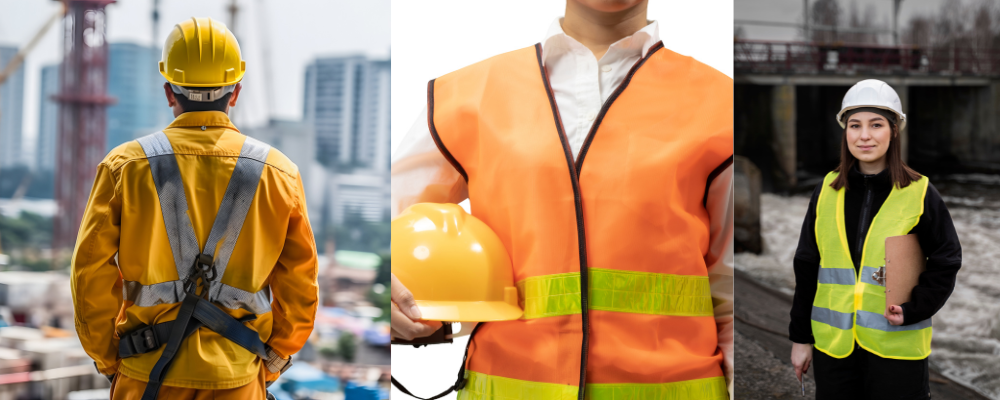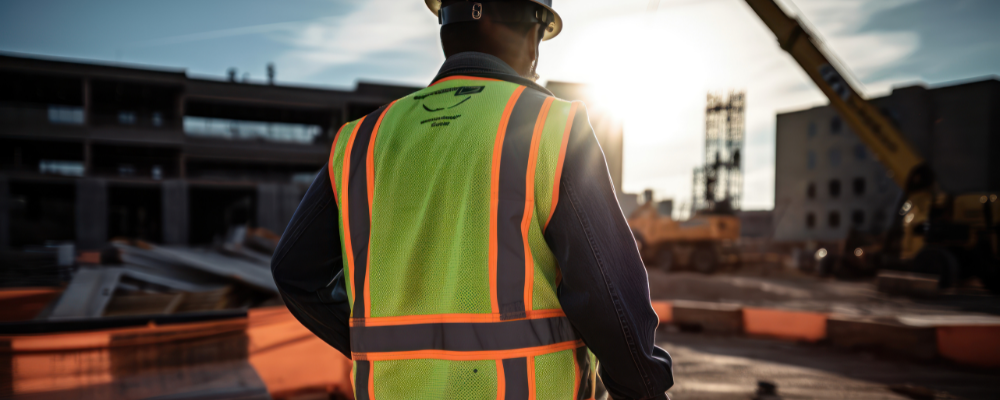
Introduction
Construction sites demand the utmost safety measures to safeguard workers from potential hazards. Among the essential safety gear, Safety Vests stand as indispensable protective equipment. This comprehensive guide delves into the significance, types, and best practices of Safety Vests tailored for construction workers.
Importance of Safety Vests in Construction
Construction workers operate in high-risk environments where visibility and identification are paramount. Safety Vests, often High-Visibility Vests, serve as a foundational safety element. These vests are designed with fluorescent colors and reflective materials to ensure maximum visibility, mitigating accidents and enhancing on-site safety.
Types of Safety Vests
1. Band Hi-Vis Vest Yellow
1-Designed with high-visibility yellow fabric
2-Prominent reflective bands for enhanced visibility
3-Ideal for daytime use on construction sites
2. Alabama Mesh Vest Yellow
1-Mesh fabric for breathability in warmer climates
2-High-visibility yellow for daytime visibility
3-Comfortable design suitable for extended wear
3. TruForce™ Class 2 Surveyor’s Safety Vest
1-Class 2 vest complying with safety regulations
2-Multiple pockets for tools and equipment storage
3-Enhanced visibility with reflective strips and bright colors
4. VIZ-PRO 5PT Break Away VEST (Orange)
1-Breakaway design for added safety in emergencies
2-Vibrant orange color for heightened visibility
3-Suitable for various working conditions

Features to Consider
1. Material Quality
The durability and resilience of safety vests largely hinge on the materials used in their construction. Optimal material quality is pivotal for withstanding the demanding and often harsh conditions in construction environments. Vests crafted from high-quality materials, such as polyester or nylon blends, are durable. These materials offer resistance to abrasions, tears, and inclement weather, ensuring prolonged protection for workers.
Polyester Blends: Vests incorporating polyester blends exhibit robustness and resistance to wear, tear, and fading, making them suitable for long-term use in rugged conditions.
Nylon Construction: Nylon-based vests provide excellent strength and resilience, maintaining their integrity even in challenging work environments.
Selecting vests with these durable materials guarantees prolonged usability, reducing the frequency of replacements and enhancing cost-effectiveness for construction companies.
2. Reflectivity and Visibility
High-visibility colors and reflective strips embedded in safety vests are critical for ensuring optimal visibility, particularly in low-light or adverse weather conditions prevalent on construction sites. These vests significantly enhance the visibility of workers, making them easily identifiable from a distance, thereby reducing the risk of accidents and collisions.
Fluorescent Colors: Vests featuring vibrant fluorescent hues, such as neon yellow, orange, or lime green, significantly improve visibility during the day, ensuring workers stand out amidst the construction landscape.
Reflective Strips: Incorporating reflective strips or tape on vests exponentially increases visibility during low-light conditions or in the presence of machinery with bright lights. These strips reflect light, making workers conspicuous and minimizing the risk of accidents.
Investing in vests equipped with high-visibility colors and reflective elements is crucial to prioritize worker safety on construction sites.
3. Comfort and Fit
Comfortable safety vests ensure workers’ ease of movement and well-being during extended work hours. Factors like adjustable straps and breathable materials significantly contribute to the comfort and suitability of vests for physically demanding workers.
Adjustable Straps: Vests designed with adjustable straps or closures allow for a customized fit, accommodating various body sizes and shapes. This feature ensures a snug fit without compromising on comfort or impeding movement.
Breathable Materials: Incorporating breathable fabrics, such as mesh panels or moisture-wicking materials, enhances air circulation, preventing excessive sweating and discomfort, especially during hot weather conditions or prolonged wear.
Prioritizing vests with adjustable features and breathable materials fosters worker comfort, reducing fatigue and optimizing performance throughout their shifts.

Best Practices for Safety Vest Usage
1. Mandatory Wear: Enforcing Strict Policy
Rationale: Safety vests are an accessory and a crucial protective gear in construction environments. Enforcing a strict policy mandating their wear significantly reduces the risk of accidents and enhances overall safety.
Implementation Steps:
- Policy Creation: Develop a concise policy outlining the mandatory use of safety vests within designated construction areas. Ensure it’s in line with local safety regulations.
- Visible Signage: Display prominent signage at entry points and throughout the construction site, reminding workers of the mandatory safety vest policy.
- Consistent Enforcement: Train supervisors and management to enforce the policy consistently. Non-compliance should not be tolerated to maintain a safe working environment.
2. Regular Inspections: Ensuring Vest Integrity
Rationale: Continuous exposure to rugged conditions can compromise the effectiveness of safety vests. Regular inspections help identify wear and tear, ensuring workers have reliable protective gear.
Implementation Steps:
- Scheduled Inspections: Establish a routine schedule for inspecting safety vests. It could be weekly, bi-weekly, or monthly, depending on the intensity of use and environmental factors.
- Checklist: Develop a comprehensive list outlining key inspection points such as reflective strips, fabric integrity, and any damages.
- Replacement Protocol: Implement a clear protocol for promptly replacing damaged or worn-out vests. Do not allow compromised vests to remain in circulation.
3. Training and Awareness: Educating Workers
Rationale: Workers’ understanding of the importance of safety vests and their proper usage is critical for compliance and effective risk mitigation.
Implementation Steps:
- Training Sessions: Conduct regular training sessions explicitly addressing the importance of safety vests, proper fitting, and when and where to wear them.
- Visual Demonstrations: Use visual aids, demonstrations, or real-life scenarios to illustrate the significance of safety vests in preventing accidents.
- Documentation: Provide written materials or guidelines detailing safety vests’ usage, care, and significance. It could be included in the onboarding process for new hires and periodically shared with existing staff.
- Feedback Mechanism: Encourage feedback from workers regarding the comfort, functionality, or any issues with the vests. Address concerns promptly to maintain worker compliance and satisfaction.
Adhering to these best practices ensures that safety vests are available and effectively utilized by construction workers, significantly reducing workplace hazards and promoting a safer working environment.
Choosing the Right Safety Vest for Your Construction Site Needs
Construction sites vary in environments and hazards. This topic delves into the diverse range of available safety vests and guides workers and supervisors in selecting the most suitable ones based on site-specific requirements. It covers factors like visibility, material, and compliance standards to aid in making informed decisions regarding safety gear.
Safety Vest Regulations and Compliance in Construction
Regulations and standards play a crucial role in ensuring the efficacy of safety vests. This topic explores the legal requirements and compliance standards set forth by regulatory bodies in the construction industry. It highlights the importance of adhering to these regulations and provides insights into how safety vests should meet specific standards for optimal worker safety.
Enhancing On-Site Safety Culture Through Safety Vest Programs
This topic focuses on the implementation of safety vest programs within construction companies. It discusses the significance of fostering a safety-oriented culture and how incorporating safety vest protocols, training, and incentives can positively impact worker compliance and safety awareness on construction sites.
For more information, visit our website and Facebook page.
For more products, visit our website :
TruForce™ Class 2 Surveyor’s Safety Vest
VIZ-PRO 5PT Break Away VEST (Orange)
Conclusion
In the bustling realm of construction, where every task carries inherent risks, Safety Vests emerge as an indispensable safeguard for the workforce. These vests are the frontline defense, a visual beacon amid construction site chaos, ensuring workers’ well-being and protection.
The fundamental importance of Safety Vests lies in their ability to enhance visibility. Their vibrant colors and reflective bands serve as a constant reminder, making workers visible even in the most challenging conditions – be it amidst heavy machinery, in low-light environments, or amidst bustling activity. This visibility significantly reduces the likelihood of accidents, preventing collisions and hazards that could lead to injuries.
Prioritizing the usage of Safety Vests within construction zones is not merely a recommendation; it’s an essential practice. By mandating the wearing of Safety Vests, companies prioritize the safety of their employees. It fosters a culture of safety, emphasizing that each worker’s well-being is paramount.
Investing in high-quality Safety Vests is pivotal in creating a safer work environment. These vests, constructed with durable materials and designed for comfort and visibility, ensure compliance and signify a commitment to worker safety. Durability ensures longevity, reducing the need for frequent replacements and offering sustained protection across various working conditions.
Ultimately, the collective impact of prioritizing Safety Vests and investing in quality resonates in creating a significantly safer work environment. A workplace where Safety Vests are not just a mandatory piece of gear but a symbol of a company’s dedication to its workers’ well-being fosters trust and loyalty among the workforce.
In conclusion, Safety Vests are more than just garments; they symbolize a company’s commitment to the safety and security of its most valuable asset – its workers. By recognizing the critical role Safety Vests play in ensuring visibility, minimizing risks, and fostering a safety-centric culture, construction companies pave the way for a safer, more secure work environment.









